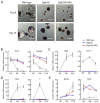Functional Dissection of pri-miR-290~295 in Dgcr8 Knockout Mouse Embryonic Stem Cells
- PMID: 31491855
- PMCID: PMC6770266
- DOI: 10.3390/ijms20184345
Functional Dissection of pri-miR-290~295 in Dgcr8 Knockout Mouse Embryonic Stem Cells
Abstract
The DiGeorge syndrome critical region gene 8 (Dgcr8) knockout strategy has been widely used to study the function of canonical microRNAs (miRNAs) in vitro and in vivo. However, primary miRNA (pri-miRNA) transcripts are accumulated in Dgcr8 knockout cells due to interrupted processing. Whether abnormally accumulated pri-miRNAs have any function is unknown. Here, using clustered regularly interspaced short palindromic repeats system/CRISPR-associated protein 9 (CRISPR/Cas9), we successfully knocked out the primary microRNA-290~295 (pri-miR-290~295) cluster, the most highly expressed miRNA cluster in mouse embryonic stem cells (ESCs), in Dgcr8 knockout background. We found that the major defects associated with Dgcr8 knockout in mouse ESCs, including higher expression of epithelial-to-mesenchymal transition (EMT) markers, slower proliferation, G1 accumulation, and defects in silencing self-renewal, were not affected by the deletion of pri-miR-290~290 cluster. Interestingly, the transcription of neighboring gene nucleotide-binding oligomerization domain, leucine rich repeat and pyrin domain containing 12(Nlrp12) was upregulated upon the deletion of the pri-miR-290~295 cluster. Together, our results suggested that the major defects in Dgcr8 knockout ESCs were not due to the accumulation of pri-miR-290~295, and the deletion of miRNA genes could affect the transcription of neighboring DNA elements.
Keywords: DiGeorge syndrome critical region gene 8; Nlrp12; cell cycle; differentiation; embryonic stem cells; miR-290~295 cluster; pluripotency; primary microRNA; self-renewal.
Conflict of interest statement
The authors declare no conflict of interest.
Figures







Similar articles
-
A DGCR8-Independent Stable MicroRNA Expression Strategy Reveals Important Functions of miR-290 and miR-183-182 Families in Mouse Embryonic Stem Cells.Stem Cell Reports. 2017 Nov 14;9(5):1618-1629. doi: 10.1016/j.stemcr.2017.08.027. Epub 2017 Oct 5. Stem Cell Reports. 2017. PMID: 28988987 Free PMC article.
-
DGCR8-dependent efficient pri-miRNA processing of human pri-miR-9-2.J Biol Chem. 2021 Jan-Jun;296:100409. doi: 10.1016/j.jbc.2021.100409. Epub 2021 Feb 10. J Biol Chem. 2021. PMID: 33581109 Free PMC article.
-
The kinase ABL phosphorylates the microprocessor subunit DGCR8 to stimulate primary microRNA processing in response to DNA damage.Sci Signal. 2015 Jun 30;8(383):ra64. doi: 10.1126/scisignal.aaa4468. Sci Signal. 2015. PMID: 26126715 Free PMC article.
-
Regulation of the MIR155 host gene in physiological and pathological processes.Gene. 2013 Dec 10;532(1):1-12. doi: 10.1016/j.gene.2012.12.009. Epub 2012 Dec 14. Gene. 2013. PMID: 23246696 Review.
-
Dgcr8 knockout approaches to understand microRNA functions in vitro and in vivo.Cell Mol Life Sci. 2019 May;76(9):1697-1711. doi: 10.1007/s00018-019-03020-9. Epub 2019 Jan 29. Cell Mol Life Sci. 2019. PMID: 30694346 Free PMC article. Review.
Cited by
-
Differential Expression of Non-Coding RNAs in Stem Cell Development and Therapeutics of Bone Disorders.Cells. 2023 Apr 14;12(8):1159. doi: 10.3390/cells12081159. Cells. 2023. PMID: 37190068 Free PMC article. Review.
References
MeSH terms
Substances
Grants and funding
LinkOut - more resources
Full Text Sources

